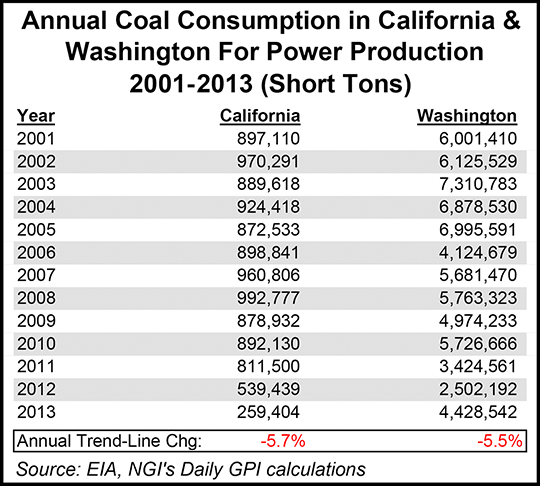Regulatory | NGI All News Access
Dumping Coal, Enacting Carbon Tax Aims of Separate Initiatives in Washington, California
With implications for the future volumes of natural gas used for electric generation, the state of Washington and a California public sector utility are the latest to push for reducing coal use and enacting a carbon tax.

A proposed statewide legislative initiative (I-732) in Washington pushed by environmental group Carbon Washington is seeking to enact a carbon tax. If the legislature does not act, the measure, if enough signatures are obtained, could be on the statewide ballot in November. The measure would be phased in over two years, eventually taxing carbon dioxide emissions at $25/ton from fossil fuels consumed in the state.
Carbon Washington has gathered more than 362,000 voter signatures supporting I-732, and plans to submit them to the legislature Monday (Jan. 11), advocating the measure as a means to achieve “cleaner” energy and fairer taxes.
The measure “encourages greater use of clean and renewable energy by taxing carbon pollution and accelerating the adoption of renewable energy,” the backers said on their website.
On Tuesday, Silicon Valley Power (SVP) in Santa Clara, CA, announced that it plans to be coal-free by the end of 2017. That’s when its contract for supplies from the San Juan Generating Station in New Mexico ends.
A combination of natural gas-fired generation and renewables would make up for the coal-fired power and help meet future load growth, SVP officials said.
SVP signed a contract for 51 MW, or about 10% of current power needs, from the coal-fired San Juan plant in in 1983, when utility officials point out there were “few clean alternatives available” to supply utility scale quantities of power. The public sector utility now generates more than half of its electricity from carbon-free resources (small hydro, large hydro, solar and wind).
Two combined-cycle gas-fired generation plants — one owned and operated in Santa Clara by SVP and another in the Lodi Energy Center — provide nearly 200 MW of the utility’s overall capacity of nearly 500 MW. Gas accounts for slightly more than 40% of SVP’s power supplies.
“Silicon Valley Power has been committed to eliminating coal as a source of electricity for our customers and turned toward a combination of new renewable resources and the ultra-modern Lodi Energy Center to replace the power from San Juan,” said SVP’s Larry Owens, customer services manager.
© 2024 Natural Gas Intelligence. All rights reserved.
ISSN © 1532-1231 | ISSN © 2577-9877 |
